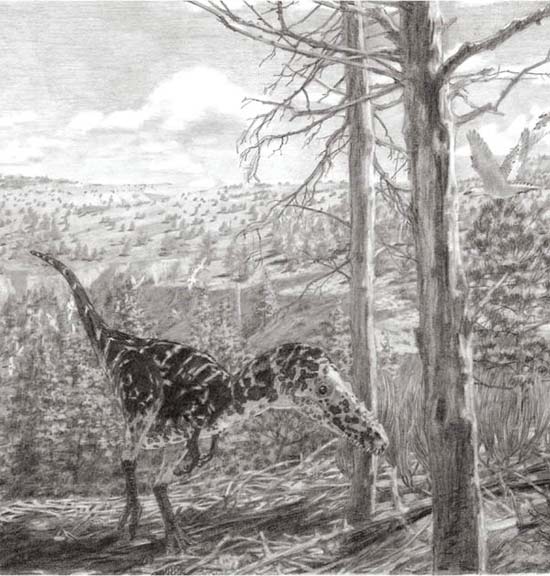Newfound Tiny Tyrannosaur Had Horns

The tyrannosaur family tree just got a little bigger. A newfound relative of Tyrannosaurus rex was a smaller, and more graceful, carnivore than its fearsome cousin, but it sported some bizarre features, including a horn and a long snout.
The newly-described T. rex cousin, described in the Oct. 5 issue of the journal Proceedings of the National Academy of Sciences, is named Alioramus altai. The exceptionally well-preserved fossil sheds light on a previously poorly understood genus of tyrannosaurs and a new suite of adaptations for meat eating.
"This spectacular fossil tells us that there is a lot more anatomical and ecological variety in tyrannosaurs than we previously thought," said Stephen Brusatte, a graduate student affiliated with the American Museum of Natural History who helped describe the fossil. "Not all tyrannosaurs were megapredators adapted for stalking and dismembering large prey. Some tyrannosaurs were small and slender. Compared to Tyrannosaurus, this new animal is like a ballerina."
The announcement comes just a few weeks after the addition of another diminutive member to the tyrannosaur family, the earlier Raptorex kriegsteini.
Family tree
Tyrannosaurs are bipedal predators that lived at the end of the Cretaceous (from 85 million years to approximately 65 million years ago). One subfamily from North America includes Albertosaurus and Gorgosaurus, while the other subfamily bridges Asia and North America and includes Tyranosaurus, Tarbosaurus, and Alioramus.
Both T. rex and Tarbosaurus are remarkably similar, even though they lived on different continents; both were predators with massive jaws and thick teeth that could crunch through bones. In fact, bite marks have been found on some fossils that were prey.
Get the world’s most fascinating discoveries delivered straight to your inbox.
Until now, Alioramus was known only from fragmentary fossils that were briefly described decades ago by a Russian paleontologist, and it has long been debated whether Alioramus was a proper tyrannosaur, a more primitive cousin, or perhaps a juvenile Tarbosaurus.
The new specimen and species, A. altai, was found on a 2001 Museum expedition to the Gobi Desert of Mongolia led by Mark Norell, Chair of the Division of Paleontology at the Museum, and Michael Novacek, Senior Vice President and Provost of the Museum. In fact, it was found at the same site as a Tarbosaurus fossil.
But although its skeleton is anatomically similar to this larger relative, A. altai is half the size; the reconstructed size is about 810 pounds (369 kilograms).
Co-existing body types
The fossil's skull is the real standout: Although this dinosaur was carnivorous, the teeth are slender, the skull has small and weak muscle attachments, and has a long snout with eight horns that were probably about five inches in length — features never seen in a tyrannosaur before.
Analysis of the braincase ties the new species closely to tyrannosaurs. CT scans of the brain by study co-author Gabe Bever, also of the museum, show the large air sacks, huge olfactory bulbs, and the small inner ear expected for a tyrannosaur.
"This fossil reveals an entirely new body type among tyrannosaurs, a group we thought we understood pretty well," Norell said. "The different body forms probably allowed Alioramus and Tarbosaurus to coexist."
The different skull structures likely meant that the two types of tyrannosaur had different eating habits.
"A. altai probably fed differently from its larger cousin, going for smaller prey because it could not crunch through bone like its larger relatives," Brusatte said.
Another co-author, Gregory Erickson, of Florida State University, analyzed the microstructure of the bone to determine that this animal died as a nine year old, essentially a teenager at 85 percent of its adult size.
The study of the fossil was supported by the National Science Foundation.
- A Brief History of Dinosaurs
- Video – The Smallest North American Dinosaur
- Images: Dinosaur Fossils



